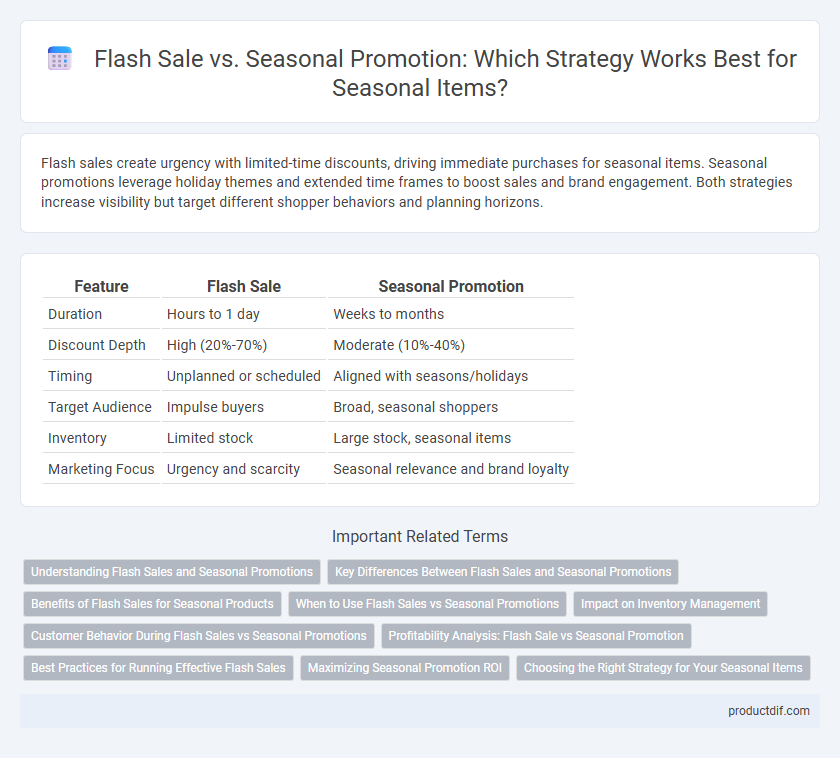Flash sales create urgency with limited-time discounts, driving immediate purchases for seasonal items. Seasonal promotions leverage holiday themes and extended time frames to boost sales and brand engagement. Both strategies increase visibility but target different shopper behaviors and planning horizons.
Table of Comparison
| Feature | Flash Sale | Seasonal Promotion |
|---|---|---|
| Duration | Hours to 1 day | Weeks to months |
| Discount Depth | High (20%-70%) | Moderate (10%-40%) |
| Timing | Unplanned or scheduled | Aligned with seasons/holidays |
| Target Audience | Impulse buyers | Broad, seasonal shoppers |
| Inventory | Limited stock | Large stock, seasonal items |
| Marketing Focus | Urgency and scarcity | Seasonal relevance and brand loyalty |
Understanding Flash Sales and Seasonal Promotions
Flash sales are time-limited discounts that create urgency and drive quick purchases, often lasting just a few hours or days. Seasonal promotions align with specific holidays or seasons, targeting customers with relevant products and offers to boost sales over weeks or months. Understanding the distinct timing, customer intent, and marketing strategies behind flash sales versus seasonal promotions helps retailers optimize inventory and maximize revenue.
Key Differences Between Flash Sales and Seasonal Promotions
Flash sales offer limited-time discounts, typically lasting a few hours to a day, aimed at creating urgency and rapid sales spikes. Seasonal promotions span longer periods aligned with holidays or seasonal changes, leveraging customer anticipation and increased demand over weeks to months. Flash sales emphasize immediate conversions, while seasonal promotions focus on sustained engagement and brand loyalty.
Benefits of Flash Sales for Seasonal Products
Flash sales create a sense of urgency for seasonal products, driving immediate purchases and boosting short-term revenue. Limited-time discounts on popular seasonal items enhance inventory turnover, reducing storage costs and minimizing leftover stock after the season ends. These rapid promotions also attract seasonal shoppers seeking exclusive deals, increasing brand visibility and customer engagement during peak buying periods.
When to Use Flash Sales vs Seasonal Promotions
Flash sales are best used for short-term inventory clearance or creating urgency during low-traffic periods, typically lasting 24 to 72 hours. Seasonal promotions are ideal for aligning with significant holidays or seasonal changes, leveraging consumer buying patterns over weeks or months. Brands should deploy flash sales to boost immediate sales and seasonal promotions to build sustained engagement and brand loyalty.
Impact on Inventory Management
Flash Sales create sudden surges in demand that require rapid inventory adjustments to avoid stockouts or overstock situations. Seasonal Promotions are planned well in advance, allowing for strategic inventory allocation tailored to predictable sales patterns during peak seasons. Efficient inventory management during these campaigns minimizes carrying costs and maximizes turnover rates, directly affecting profitability.
Customer Behavior During Flash Sales vs Seasonal Promotions
Customer behavior during flash sales often involves urgency and impulse buying driven by limited-time offers and significant discounts, which can lead to a spike in short-term sales volume. In contrast, seasonal promotions encourage planned purchases aligned with holidays or seasonal needs, fostering brand loyalty and sustained engagement over a longer period. Flash sales trigger rapid decision-making, while seasonal promotions emphasize value and relevance to recurring customer buying cycles.
Profitability Analysis: Flash Sale vs Seasonal Promotion
Flash sales generate rapid spikes in revenue by creating urgency and attracting bargain hunters, leading to increased turnover and inventory clearance. Seasonal promotions typically result in steadier, sustained sales over a longer period, optimizing profit margins through targeted marketing and customer loyalty. Profitability analysis often shows flash sales improve cash flow quickly but can erode margins, whereas seasonal promotions balance sales volume with higher profit per unit.
Best Practices for Running Effective Flash Sales
Flash sales require precise timing and urgency to maximize customer engagement, offering deep discounts for a limited period that drives immediate purchases. Seasonal promotions benefit from aligning with holiday themes and consumer behavior patterns but lack the intense urgency of flash sales. Best practices for flash sales include clear communication of the sale duration, leveraging social media for rapid promotion, and ensuring inventory readiness to handle sudden demand spikes efficiently.
Maximizing Seasonal Promotion ROI
Flash sales generate immediate spikes in sales but often sacrifice long-term profitability by reducing margins. Seasonal promotions leverage targeted timing and tailored messaging to engage customers throughout the season, increasing overall brand loyalty and lifetime value. Maximizing ROI in seasonal promotions involves strategic inventory management, personalized offers, and data-driven analysis to sustain higher average order values and repeat purchases.
Choosing the Right Strategy for Your Seasonal Items
Flash sales create urgency by offering significant discounts for a limited time, making them ideal for clearing out seasonal inventory quickly. Seasonal promotions, which often include bundled deals or seasonal-themed marketing, help build brand engagement and sustain customer interest throughout the season. Selecting the right strategy depends on your goals: use flash sales for rapid turnover and seasonal promotions to enhance customer experience and long-term sales.
Flash Sale vs Seasonal Promotion Infographic

 productdif.com
productdif.com